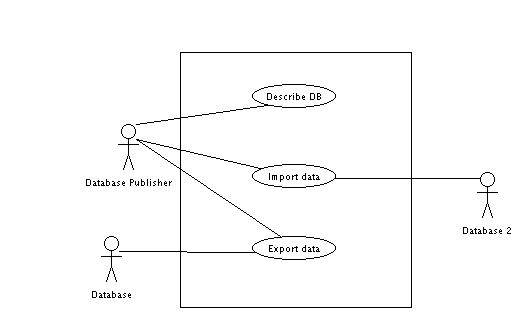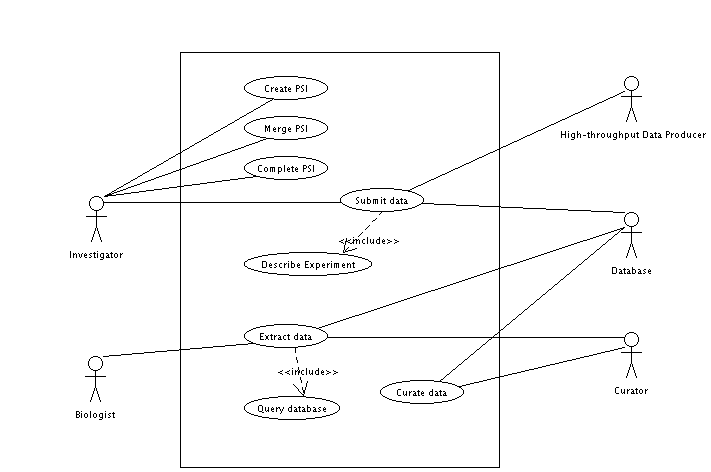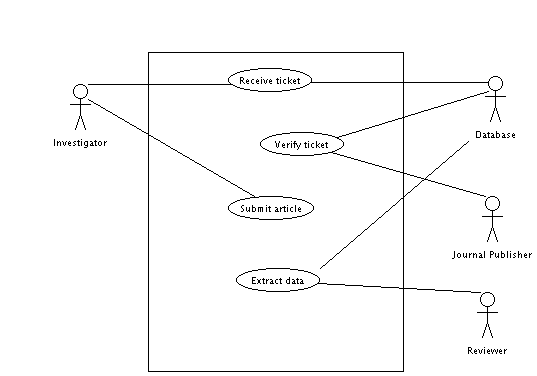- Actors
- Use Cases 1 - peer-to-peer data exchange
- Use Cases 2 - data submission and curation
- Use Cases 3 - formal publication
Actors
Database
A Database of molecular interactions stores relations between proteins, DNA and other molecules.
Database 2
Same as Database
Database Publisher
A Database Publisher maintains and distributes a database of molecular interactions.
High-throughput Data Producer
A High-throughput Data Producer uses large-scale techniques such as systematic screens to produce interaction data in large quantities.
A High-throughput Data Producer works in a large structure and is assumed to benefit from a laboratory information management system (LIMS) with standardized operating procedures and quality assurance methods, as well as from the presence of bioinformatics support staff.
Curator
A Curator reviews, verifies and edits data in a database in order to improve the quality of the information that is made available to data consumers.
Biologist
A Biologist consults a database to extract data in a useful form for his or her scientific activity. The can happen as soon as the data are deposited in the database (and once any embargo is lifted), and need not wait for formal publication of the results in a peer-reviewed journal.
Investigator
An Investigator is an individual researcher (and his or her research team), who uses small-scale techniques to analyze interactions of proteins of interest.
An Investigator works in a small, independant structure, without necessarily benefiting from a laboratory information system (LIMS) or bioinformatics support personnel. Data will most often be initially created using ad hoc tools such as spreadsheets.
Journal Publisher
A Journal Publisher receives submitted articles, verifies that the associated interaction data was indeed submitted to a public Database, and transmits the article to the Reviewer for evaluation.
Reviewer
A Reviewer evaluates an article for a Journal Publisher. This evaluation may include consultation of the submitted experimental data.
Use Case 1 - peer-to-peer data exchange

Describe DB
Describe source database, so that importers understand how we (Database Publisher) use the PSI-MI format to represent our data.
Import data
Database Publisher imports data from Database 2, interpreting PSI-MI records according to his understanding of the use of PSI-MI by Database 2.
Export data
We (Database Publisher) export data from Database. Note that there is no association to Database 2 or its Database Publisher, since we don't know who will do the importing or indeed that it will be imported anywhere at all.
Use Cases 2 - data submission and curation

Submit data
The Investigator submits finished data sets to the database using the PSI-MI format.
Describe Experiment
In order to provide a conforming submission, the Investigator must describe the experimental procedure and the kind of interactions that were detected, using appropriate controlled vocabularies.
Create PSI
The Investigator creates an initial PSI-format file, typically from a CSV-formatted spreadsheet file. This initial PSI file need not be canonical, we anticipate that only "interaction" records will be present. Tools must be provided to convert this initial, minimal, PSI file to canonical form.
Merge PSI
An Investigator can generate separate PSI files, one for each spreadsheet. Tools must be provided to merge these files into a coherent, submittable PSI file.
Complete PSI
Initial PSI files do not necessarily contain all the information related to the experiments, interators, and interactions that are needed for submittable PSI files. The Investigator completes the information in the initial file, using tools for manipulating PSI data.
Curate data
Curation involves modifying records, adding or deleting parts of the record; merging database records to produce nonredundant data sources; and deleting records that are judged to be false or inaccurate. This curation may use standalone tools using PSI-MI as an interchange format, or database-specific tools. In both cases PSI concepts and controlled vocabularies should be used.
Query database
In extracting data from databases, Investigators, Biologists and other data consumers formulate queries. These queries should use PSI-MI concepts and controlled vocabularies.
Use Cases 3 - formal publication

Receive ticket
An Investigator submits his or her experimental data to a Database, and receives a deposit ticket that justifies that the data were indeed received.
Verify ticket
A Journal Publisher verifies that the data associated with an article under consideration for publication were indeed deposited, by querying the Database with the deposit ticket that the Investigator provides.
Submit article
An Investigator submits an article to a Journal Publisher for consideration, and supplies the deposit ticket that permits the Journal Publisher to verify that the associated experimental data were indeed deposited.
Extract data
Investigators, Biologists and other data consumers can extract data in PSI-MI format from databases.
Extraction for Reviewers should be allowed even when the data are under embargo pending publication.

